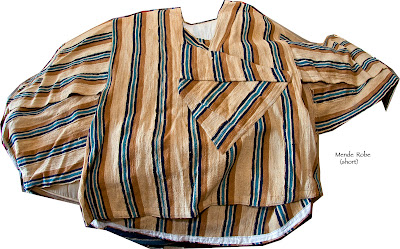
above Salia Koroma - famous Mende singer wears distictive Mende hat seen in hat section below
 Typical Country Cloth - 5'6" x 7'6" - this was made near Kenema
Typical Country Cloth - 5'6" x 7'6" - this was made near Kenema

 Typical Country Cloth - 5'6" x 7'6" - this was made near Kenema
Typical Country Cloth - 5'6" x 7'6" - this was made near Kenema
Above - another typical country cloth from near Kenema - 5' 4" x 6' 8"
 KURANKO MAT MAKER (WITH APPRENTICE) - VILLAGE OF SOKURELLA
KURANKO MAT MAKER (WITH APPRENTICE) - VILLAGE OF SOKURELLA
double click on any photo to enlarge
KURANKO MAN'S ROBE FROM SOKURELLA

 KURANKO MAT MAKER (WITH APPRENTICE) - VILLAGE OF SOKURELLA
KURANKO MAT MAKER (WITH APPRENTICE) - VILLAGE OF SOKURELLAdouble click on any photo to enlarge
Native Hats (above): mainly worn upcountry from left to right - the orange and green cap was typical of our area Fula Caps; there are two somewhat stylish Kuranko men's dress caps - these have European thread; The brown (kola dyed) hat is that type worn by Kuranko hunters - this is the only one made of native cotton cloth; the cap on the top right is a typical Mende man's hat as he might wear on a trek to town or a special celebration. Above there is a picture of a Kuranko mat maker with apprentice in the village of Sokurella. Taken in 1970, he is wearing a typical Kuranko dress hat and country cloth robe.
Up top - the above two country cloths come from near Kenema and are more typical of the cotton cloth that might be used for clothing or perhaps a bed spread. Not complicated. No tapestry weave on top - these were more typically found in villages around where we lived. Woven by men after the cotton was harvested - a good portion of the production was shared by the women who picked the cotton, made the thread, and dyed the thread.


KURANKO MAN'S ROBE FROM SOKURELLA

MENDE MAN'S COUNTRY CLOTH ROBE - MADE NEAR KENEMA
the 3 robes above are all from native cotton, and woven in villages. The top robe is from Sokurella in the Loma Mountains. It was a typical Kuranko country man's robe from that era and in that area. The other two robes were made near Kenema and were typical of what a village man might wear when he got dressed up. The robes were comfortable in the hot and humid climate of Sierra Leone. Open on the sides to allow air - the pocket over the area just below the neck could be used to carry valuables. This would also be true of a side pocket. A communication from Nikiibu reveals that in Mende these robes were called Bobani - a name that I had forgotten.


4 comments:
Always a pleasure SL1968-70 to visit your sites. Have a couple of those 'bobani' robes, in the style as those you show here.
Have you thought of doing a gallery display or some such thing with what seems like a good collection in your possession? But of course that involves time and effort, and those aren't easy to come by.
Very, very good. Keep them coming!
I remember that they were called bobani now that you remind me. I was unable to remember it before your post.
[1] can you tell me what the different sized country cloth was called. I remember there being a variety of sizes of the tapestry woven cloth but all I can come up with is kpoikpoi. If you could give me the Mende names for these clothes I would appreciate it.
[2] I am working with other Peace Corps volunteers to try and put together a show of photographs and items that as Peace Corp Volunteers and Friends of Sierra Leone may have been collected over the years. The idea would be to show the many wonderful images and things that we all admired and may in some way help to show what a proud and wonderful country Sierra Leone is. As you know the War did a job on its youth, but also on the entire country. I have show some of my items locally where I live. The challenge is how to have the show be a beautiful expression of what we all saw, and make it also so that we get guidance and input from our many Sierra Leonean friends. Since we had volunteers all over the country I think a well-organized show would be all encompassing, tremendously diverse, and would be of interest and well-received. You are right that this task is not easy.
My research didn't yield much beyond what I already knew. 'Kpokpoi' is the tapestry you showed. 'Kondi gulei'(traditional cloth) would be the more common weaving pattern. As for sizes, there's just one word: 'Gbai' (gbai yela, fele, sawa, etc. or 1, 2, 3 gbai).
A Gbai would be the approx. size of a bedsheet.
"kpokpoi" is there not a similar word in Mende that refers to the chin. A well-known women in our area (Mama Hokey) nick-named one of her young nieces Hokey Kpokpoi because as I remember it she had a prominent chin like I did. Mama Hokey callled this child my sister because we both had this. I took the work kpokpoi (or something similar) to thus refer to the chin. Wouod be interested Nikiibu in your thoughts. Thanks
Post a Comment